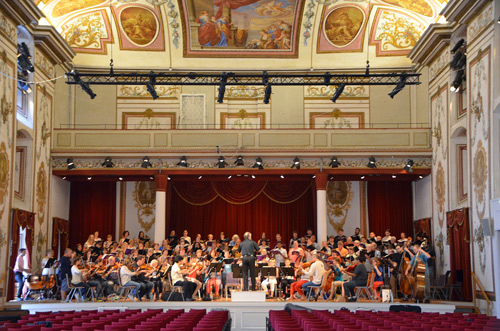In the summer of 2014, as part of Eisenstaedt Austria’s 39th annual Classical Music Festival, Mark Wade, assistant professor of music and trumpet musician, travelled Austria for more than two weeks performing and soaking up musical history.
After an extensive application process, which included a CD audition, a CV review, and letter of recommendation, Wade was selected to serve as second trumpet in the festival’s orchestra. The renowned assemblage is composed of professional musicians from around the world and is sanctioned by the College Music Society. The festival chorus included professional singers as well as two university choruses.
The 650-year-old Eszterházy Palace served as the home base for the festival and provided grand rehearsal space as well as the setting for a few concerts. Wade said, “The opportunity to play music at such a high level in such a historic and beautiful place was a highlight of my career.”
Haydn and Beethoven, as well as Johann Hummel, who was especially known for his trumpet concerto, served as court musicians in Eszterházy Palace. “To have this connection — walking the halls where they lived and playing on the stage where they first played is amazing,” said Wade.
Prior to the Baroque era (1600-1750) the trumpet was used mainly as a military instrument. During the time of J.S. Bach, the trumpet enjoyed a short stint as an indoor chamber instrument. In the Classical period, however, the role of the trumpet was demoted from melodic to punctuation, often doubling the timpani. It was during Haydn’s time in the late 18th century when the keyed bugle was invented, which allowed for a larger range of pitches and melodic playing once again.
Haydn and his successor Hummel each wrote two of the most famous trumpet concerti, which created new opportunities for the instrument and remain a staple for classical trumpet players today. “This was a turning point in musical history.” Both concerti were premiered in Esterhazy Palace.
The festival orchestra and chorus performed Haydn’s “Schöpfungsmesse” (Creation Mass) in Bergkirche, the historic church for which Haydn composed the work. During the tour, Wade was invited to perform trumpet solos with his colleague. The two played double trumpet concertos in tandem with Haydn’s original organ.
“Hearing my trumpet reverberate in the same halls where the great musicians and composers of history performed is like time travel,” said Wade. “As a trumpet scholar I have studied these pieces for a long time, but you can’t replace the opportunity to play where they originated,” he added.
Wade also researched and furthered scholarship on Haydn during the festival. While reading Haydn’s handwritten scores, Wade and his colleagues discovered a discrepancy between current recordings and printed editions of “Creation Mass” and Haydn’s original manuscript. The orchestra reflected the composer’s original intent in their performance at the festival.
During the festival, Wade also steeped himself in musical history. He visited Haydn’s mausoleum and his apartment, as well as the gravesites of composers including Shubert, Brahms, Schumann, Beethoven, Schönberg and Strauss II. He also toured one of Beethoven’s apartments. In Slovakia he visited the Bratislava home where Hummel was born and the residence wherein Beethoven composed his “Moonlight Sonata.”






